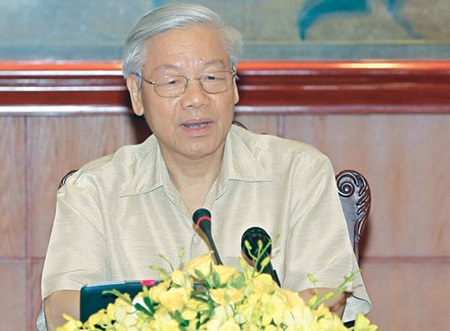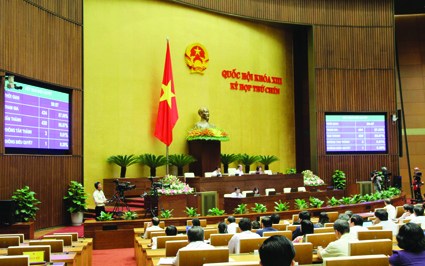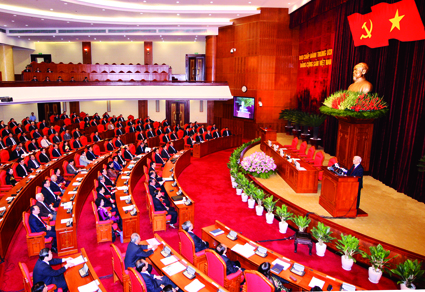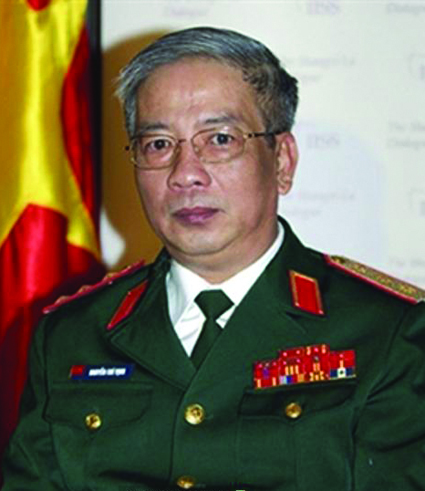Nguyen Phuoc Tho
Government Office
Passed by the National Assembly last month, the Law on Organization of the Government (amended) (the Law) is designed to promote democracy, rule of law, initiative, flexibility and creativeness in, and raise the effectiveness and efficiency of, the operation of the Government in administration work to serve the people. The Law consists of 50 articles and will take effect next year. This article presents some insightful ideas on important provisions of the Law.
Upholding and concretizing the executive function of the Government in the context of building a law-ruled state; completing the legal framework for promoting the initiative and flexibility in the operation of the Government
The 2013 Constitution makes a big stride in the constitutional history of the Vietnamese State when it affirms the executive nature, functions, tasks and powers of the Government. The executive powers of the Government include organizing the implementation of the Constitution and laws and proposing and formulating national policies.
In the Law, the provisions on the executive tasks and powers of the Government have the following two most important new points.
Firstly, unlike the 2001 Law, the Law strongly affirms the primary tasks and powers of the Government to organize the implementation of the Constitution and laws[1], first of all the task and power to make implementing regulations: “To promptly and fully promulgate legal documents to implement the Constitution, laws, resolutions of the National Assembly, ordinances and resolutions of the National Assembly Standing Committee, orders and decisions of the President, and to perform assigned tasks.” (Clause 1, Article 6).
This is not only an advance in lawmaking techniques but also demonstrates a clear awareness about the executive role and responsibility of the Government in the context of building a law-ruled state in which law is regarded as the most important tool in the organization and operation of the state administrative apparatus.
Secondly, the Law concretizes the policy-making competence of the Government. The Government has the task and power to propose and formulate policies, strategies, master plans, plans and other programs and projects to be submitted to the National Assembly or the National Assembly Standing Committee for consideration and decision, or decide on them according to its competence (Clauses 1 and 2, Article 7).
Addressing the limitations of the current Law, the Law contains a number of provisions to renovate the methods of performing tasks and exercising powers of the Government in a flexible and effective manner.
Firstly, in addition to further upholding the principles and a number of important contents of decentralization to serve as a basis for continued rational decentralization of powers in all fields, the Law affirms for the first time the principle of rational division of powers in the organization and operation of the Government. This is a prerequisite for building a government sharing powers with local administrations and stepping up the vigorous renovation of the operation of the Government, ministries and sectors, with a view to step by step forming self-governing local administrations.
Secondly, concretizing the provisions of the 2013 Constitution, the Law clearly states that the Government must authorize local administrations to perform a number of tasks together with conditions to guarantee the fulfillment of such tasks (Clause 1, Article 25).
Thirdly, the Law does not retain the provisions of the current Law on important issues which must be brought up to cabinet meetings for collective discussion and majority voting[2]. Meanwhile, it clearly defines the responsibility of the Prime Minister: “In case the Government does not convene a meeting, the Prime Minister shall decide to seek written opinions from the cabinet members.” (Clause 2, Article 44).
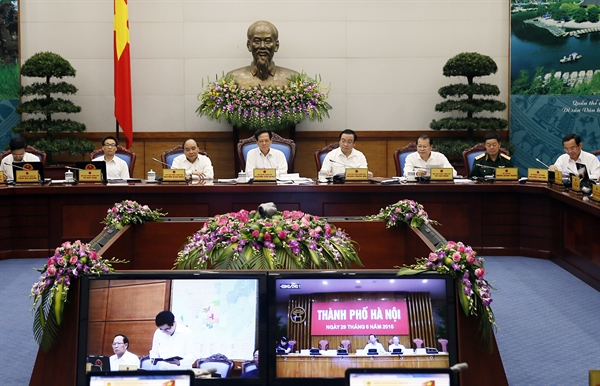 |
| Prime Minister Nguyen Tan Dung chairs the online Government meeting with the provinces and cities on June 29 __Photo: Duc Tam/VNA |
Clearly determining the position and further upholding the role and responsibility of the Prime Minister in the state administration system
For the first time, the 2013 Constitution affirms that the Prime Minister is the head of the Government and clearly defines the scope of responsibility of the Prime Minister: “... responsible to the National Assembly for the works of the Government and assigned tasks” (Clause 2, Article 95). In the spirit of the new provisions of the Constitution on tasks, powers and responsibilities of the Prime Minister with regard to the state administration system from the central to local level, the Law makes an important stride when affirming more fully and clearly the position of the Prime Minister as “the head of the Government and state administration system” (Clause 2, Article 4). With this provision, the institution of the Prime Minister has basically been completed as an independent one that has a clear position and separate functions, tasks and powers and operates under the single-chief regime. This is very significant for promoting the role and responsibility of the Prime Minister in leading and administering the work of the Government, ensuring the unity of the Government and the state administration system. At the same time, it creates a ground for assignment and separation of fundamental activities of the state administrative apparatus at the central level, with the Government concentrating on making and issuing management mechanisms, policies and institutions; the Prime Minister leading and administering the work of the Government and state administration system; and ministers and heads of ministerial-level agencies organizing the implementation of policies and laws in the management of their sectors or fields.
The greatest reform brought about by the 2013 Constitution is the transfer of the leading role in and responsibility for the operation of the state administration system from the Government to the Prime Minister, which aims to ensure the unity of the national administration. In this light, the Law not only transfers relevant tasks and powers of the Government to the Prime Minister but also adds some new tasks of the Prime Minister in order to elevate the role and responsibility of the head of the administration system for stepping up administrative reform, enhancing order and discipline and building a unified, well-functioning, continuous, democratic and modern administration system serving the people.
Six tasks and powers of the Government[3] that are wholly or partially transferred by the Law to the Prime Minister include: (1) “To manage and administer the operation of the state administration system from the central to local level...”; (2) “To direct and unify the management of cadres, civil servants and public employees in the state administration system from the central to local level...”; (3) “To lead, direct, examine and inspect the performance of official duties by cadres and civil servants in the state administration system”; (4) “To lead and direct the examination and inspection of the management of cadres, civil servants and public employees in the state administration system from the central to local level”; (5) “To decide on the decentralization of the management of civil servants and public employees in administrative agencies of the state apparatus”; (6) “To lead and direct the management and administration of all physical foundation, finances and state budget sources to serve the operation of the state apparatus”; and (7) “To lead and direct the administrative reform and reform of the regime of official duties and civil servants in the state administration system from the central to local level.”[4]
The first task is wholly transferred from the Government to the Prime Minister, while the remaining tasks are separated from a number of tasks of the Government and mainly related to the management of cadres, civil servants and public employees in the state administration system[5].
The Law also assigns six new tasks and powers to the Prime Minister, including: (1) “To lead and direct chairpersons of provincial-level People’s Committees in implementing laws and regulations and the Government’s programs, plans and strategies in all fields of management...”; (2) “To lead, direct, inspect and handle violations in the implementation of the Constitution and laws nationwide”; (3) “To submit to the National Assembly Standing Committee for approval the appointment or relief from duty ambassadors extraordinary and plenipotentiary of the Socialist Republic of Vietnam to foreign countries”; (4) “To accept resignations of deputy ministers and officials of equal rank of ministries and ministerial-level agencies; to suspend the work of chairpersons and vice chairpersons of provincial-level People’s Committees; to request chairpersons of provincial-level People’s Committees to suspend the work of or dismiss chairpersons and vice chairpersons of People’s Committees at lower levels”; (5) “To decide to appoint acting ministers or heads of ministerial-level agencies...; to decide to appoint acting chairpersons of provincial-level People’s Committees in case of vacancy of chairpersons”; and (6) “To decide on criteria and conditions for establishment or dissolution of special professional or specialized agencies of provincial- and district-level People’s Committees; to decide on the establishment of other agencies and organizations of provincial-level People’s Committees.”[6]
The new tasks and powers of the Prime Minister are aimed at nothing but upholding the position, role and responsibility of the Prime Minister in order to ensure the initiative, flexibility, responsiveness and timeliness in management and administration work, and the unity, smoothness and continuity in the organization and operation of the Government and the national administration system at all levels. Among them, the fourth and fifth tasks and powers related to personnel work of the administration system are the most important because they serve as the most important tools in guaranteeing the full exercise by the Prime Minister of his role and responsibility in leading and administering the works of the Government and the state administration system.
With the tasks and powers assigned to the Prime Minister, the Law provides for the first time a mechanism that guarantees full exercise of powers by assigning management and administration tasks to the Prime Minister in combination with upholding his accountability and empowering him to administer state finance and budget and decide on personnel affairs in order to ensure the performance of assigned tasks.
In order to ensure the initiative, flexibility and effectiveness in the performance of assigned tasks and the exercise of vested powers, the Law has a provision that the Prime Minister may decide to decentralize the management of cadres, civil servants and public employees, and authorize ministers and heads of ministerial-level agencies to perform one or several of the tasks within his competence (Points dd and g, Clause 2, Article 28).
 |
| Ho Chi Minh City municipal People’s Committee’s hall __Photo: Internet |
Clearly defining the relationship between ministers or heads of ministerial-level agencies and their ministries or ministerial-level agencies; renewing the functions of ministries and ministerial-level agencies
The current Law on Organization of the Government, specialized laws and documents of the Government all affirm a hierarchy that ministries and ministerial-level agencies are placed above ministers and heads of ministerial-level agencies. Accordingly, the tasks and powers of ministers and heads of ministerial-level agencies must stem from the functions, tasks and powers of ministries; and ministers are responsible for performing the tasks and exercising the powers of their ministries. This hierarchy is not conformable to the 1992 Constitution and the 2013 Constitution.
The Law redefines the above relationship in the spirit of the Constitution. It has a chapter on the tasks and powers of ministers and heads of ministerial-level agencies (Chapter IV), followed by a chapter on ministries, ministerial-level agencies and government-attached agencies (Chapter V). The Law employs a fresh approach in defining tasks and powers of ministers and heads of ministerial-level agencies based on their capacity as cabinet members and their capacity as heads of ministries or ministerial-level agencies with the responsibility to lead the work of their ministries or ministerial-level agencies, perform the state management of assigned sectors or fields, and organize and supervise the implementation of laws relevant to such sectors or fields nationwide.
Under the Law, ministries and ministerial-level agencies have the function of state management of one or more than one sector or field (Clause 1, Article 39), but the hierarchy provided in the 2001 Law has been inverted. The functions of ministries and ministerial-level agencies now stem from and are formed on the basis of the powers and responsibilities of ministries and heads of ministerial-level agencies enshrined in the Constitution. This is an important progress in legislative perception and techniques. The Law affirms that ministers and heads of ministerial-level agencies are administrative heads of sectors or fields assigned to them and have the highest administrative authority over such sectors or fields. The organizational structures of ministries and ministerial-level agencies are established to assist their ministers or heads to exercise such authority. Functions and authority of ministries and ministerial-level agencies are transformed from those of ministers and ministers are totally responsible for all management activities of their ministries over assigned sectors or fields.
The positions and functions of ministries and ministerial-level agencies are stipulated by the Law as follows: "Ministries and ministerial-level agencies are governmental agencies performing the function of state management of one or several sectors or fields and public services in these sectors or fields; organizing and inspecting the implementation of laws relevant to these sectors or fields nationwide” (Clause 1, Article 39).
Compared to the 2001 Law, this provision of the 2015 Law has two new points: (1) It abolishes the function of representing the owner of state capital in state-invested enterprises; and (2) It adds the function of organizing and inspecting the enforcement of relevant laws nationwide.
On the one hand, these new points reflect a legislative effort to improve the effectiveness and effect of state management and law enforcement by ministries and ministerial-level agencies in their sectors or fields nationwide in the context of building and perfecting a law-ruled state. On the other hand, the addition of the function of organizing law enforcement is an important move toward clear-cut assignment of tasks between the Government and Prime Minister and ministries and ministerial-level agencies. It means that ministries and ministerial-level agencies must direct themselves toward playing the main role of organizing law enforcement in their sectors or fields.
In order to streamline the organizational apparatus in the spirit of the administrative reform has for the first time become a legislative solution, the Law specifies the number of deputy ministers or deputy heads and organizational structures of ministries and ministerial-level agencies, creating a firm institutional framework for stepping up the reform of organizational apparatuses and renewal of working styles of central state administrative agencies.
Regarding the number of deputy ministers or deputy heads, the Law stipulates: “The maximum number of deputy ministers or deputy heads of a ministerial-level agency is 5; the maximum number of deputy ministers of the Ministry of National Defense, Ministry of Public Security and Ministry of Foreign Affairs is 6. In case of merger of ministries or ministerial-level agencies or secondment or transfer of cadres as requested by competent agencies, the Prime Minister shall submit the number of deputy ministers or deputy heads to the National Assembly for consideration and decision” (Clause 2, Article 38);” and “The maximum number of deputy heads of a division, an office, an inspectorate, a department or a public non-business unit is 3; the maximum number of deputy heads of a general department is 4” (Clause 2, Article 40).
These provisions aim to strictly control and curb the increase in the number of deputy heads in the central state administrative apparatus.
Under the Law, the organizational structure of a ministry or ministerial-level agency is composed of “vụ (department), văn phòng (office), thanh tra (inspectorate), cục (bureau, agency or authority) and tổng cục (general department); and đơn vị sự nghiệp công lập (public non-business units)” (Clause 1, Article 40). This provision is designed to ensure long-term stability and uniformity of framework organizational structures of ministries and ministerial-level agencies.-

